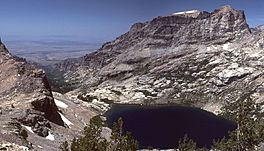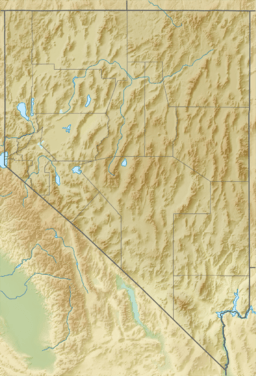Echo Lake (Nevada) facts for kids
Quick facts for kids Echo Lake |
|
|---|---|
 |
|
| Location | Ruby Mountains, Elko County, Nevada |
| Coordinates | 40°36′42″N 115°26′48″W / 40.61167°N 115.44667°W |
| Type | tarn |
| Primary outflows | Echo Creek |
| Basin countries | United States |
| Surface area | 29 acres (12 ha) |
| Max. depth | 155 ft (47 m) |
| Surface elevation | 9,830 ft (3,000 m) |
Echo Lake is a beautiful, clear lake found high up in the Ruby Mountains of Nevada. It's located in Elko County, in the northeastern part of the state. This special lake is known as a glacial tarn, which means it was formed by a glacier long ago.
Echo Lake sits at the very top of a quiet place called Echo Canyon. It's quite high up, at about 9,830 feet (2,995 meters) above sea level. The lake covers an area of about 29 acres (11.7 hectares). It's also very deep, reaching down to 155 feet (47 meters). This makes Echo Lake the largest and deepest lake in the entire Ruby Mountains range!
Contents
About Echo Lake
Echo Lake is a natural wonder, created by the powerful forces of ice and time. It's a key part of the Ruby Mountains, a mountain range often called "Nevada's Alps" because of its stunning peaks and valleys.
How Echo Lake Formed
Echo Lake is a type of lake called a "tarn." Tarns are lakes that form in the hollows or bowls carved out by glaciers. Imagine a giant river of ice slowly moving down a mountain. As it moves, it scrapes away rock and soil, creating a deep, bowl-shaped depression. When the glacier melts, this bowl fills with water, forming a tarn. Echo Lake is a perfect example of this natural process.
Location and Features
The lake is nestled in a remote and peaceful area. Its high elevation means the water is very cold and clear. The surrounding landscape is rugged and beautiful, with tall peaks and rocky slopes. Because it's so high up, the air is thin, and the views are amazing.
Water Flow and Importance
Echo Lake is more than just a pretty sight; it's an important source of water. It's the main starting point for Echo Creek. This creek flows out of the mountains and eventually joins other streams. Together, these streams form the South Fork of the Humboldt River. This river is a vital waterway in Nevada, supporting wildlife and communities further downstream.
See also


